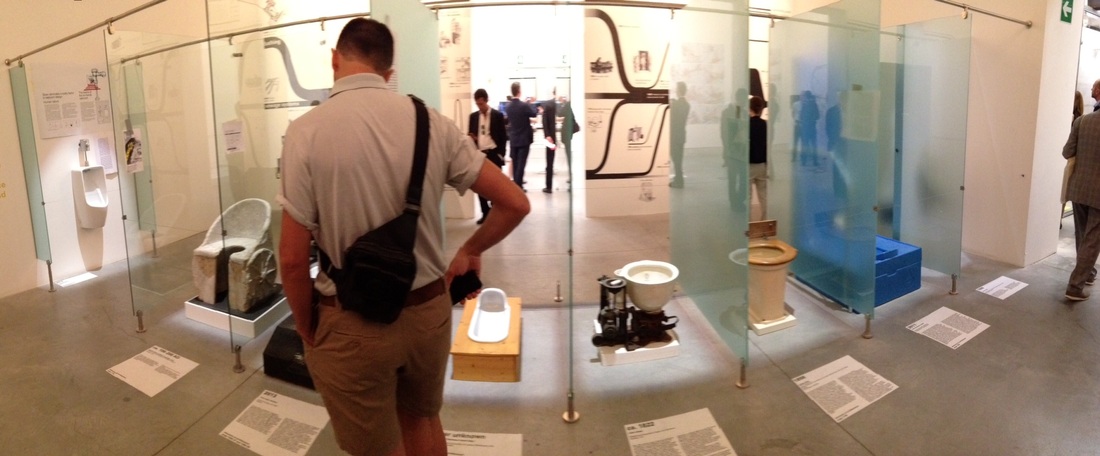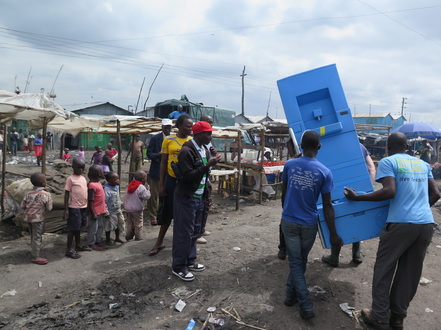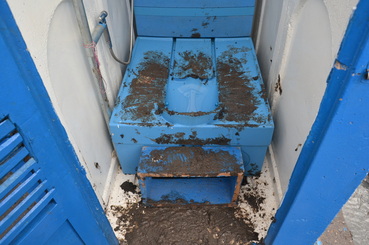I had the pleasure of visiting the opening of the 14th Mostra Internazionale di Architettura in Venice last week. The prestigious Architecture Venice Biennale is held every two years and showcases innovations and tendencies in the built environment. The guiding theme of the 14th Venice Architecture Biennale was “Fundamental Elements of Architecture”, re-examining the fundamentals of architecture: “the floor”, “the façade”, “the door”, … and of course “the toilet”. While not seen as a primordial element of architecture, the exhibitors note that “The toilet might be the ultimate element…the great unspoken driver behind much architecture and urban planning” (Koolhaas, 2014).
The Blue Diversion Toilet has been selected for exhibit in the main “Fundamentals” exhibition, curated by the renowned Dutch architect Rem Koolhaas. It stands prominently next to a Japanese high-tech toilet and one of the first commercialized flush toilets - the Optimus Valve Closet developed in 1870 by Stevens Hellyer. Eawag’s Blue Diversion was selected as an example of a “21st century outhouse” that seeks to push the frontiers of technological innovation beyond the flush-and-forget solution invented 240 years ago (by A. Cummings in 1775 – it took almost 100 years to reach commercialization!).
The Blue Diversion Toilet has been selected for exhibit in the main “Fundamentals” exhibition, curated by the renowned Dutch architect Rem Koolhaas. It stands prominently next to a Japanese high-tech toilet and one of the first commercialized flush toilets - the Optimus Valve Closet developed in 1870 by Stevens Hellyer. Eawag’s Blue Diversion was selected as an example of a “21st century outhouse” that seeks to push the frontiers of technological innovation beyond the flush-and-forget solution invented 240 years ago (by A. Cummings in 1775 – it took almost 100 years to reach commercialization!).
Blue Diversion was selected by the Biennale for its great design appeal but also because it was the first “re-invented” toilet to hit the tough realities of the Global South – two photos at the stand show the initial working model being installed in a slum in Kampala, Uganda. While the Blue Diversion Toilet has not been industrialized yet, witnessing it in this historical context of centuries of sanitary development gives hope that we’re on to something bigger – the next sanitary revolution.
The Architecture Biennale can be visited till 23th November 2014 www.labiennale.org
by C. Lüthi, Eawag-Sandec
Koolhaas, R. 2014. “Toilet - Elements of Architecture”. Harvard University Graduate School of Design, Edition Marsilio, Italy.
The Architecture Biennale can be visited till 23th November 2014 www.labiennale.org
by C. Lüthi, Eawag-Sandec
Koolhaas, R. 2014. “Toilet - Elements of Architecture”. Harvard University Graduate School of Design, Edition Marsilio, Italy.





 RSS Feed
RSS Feed

